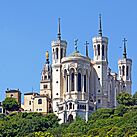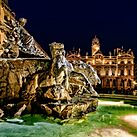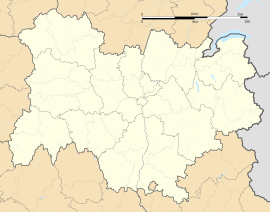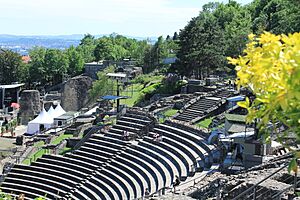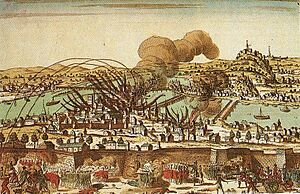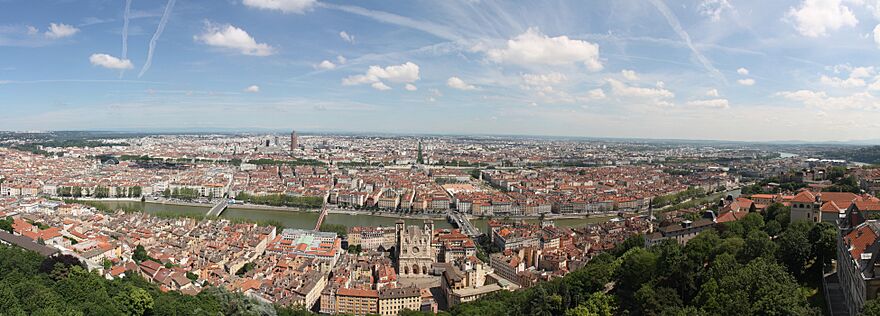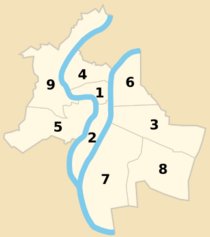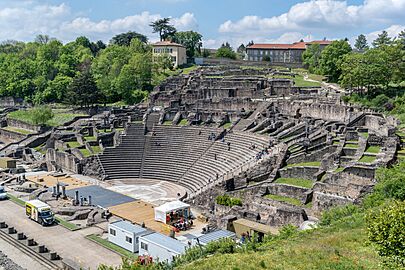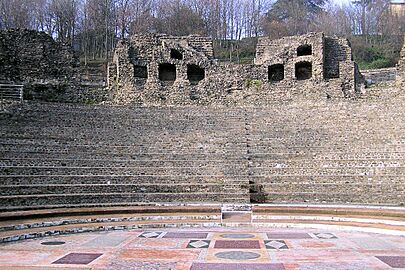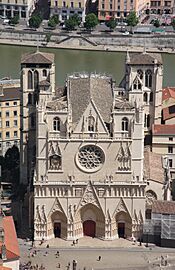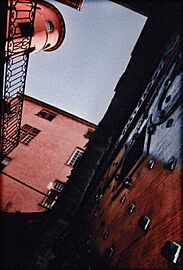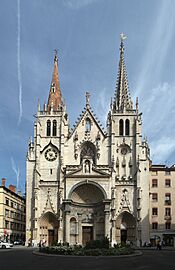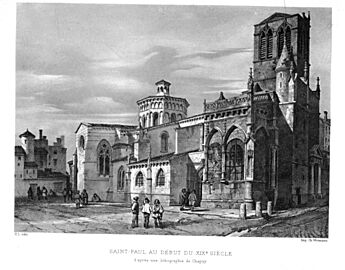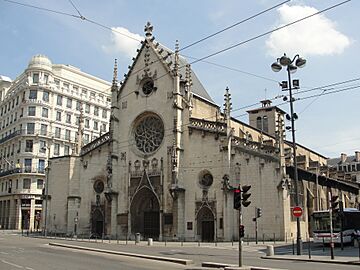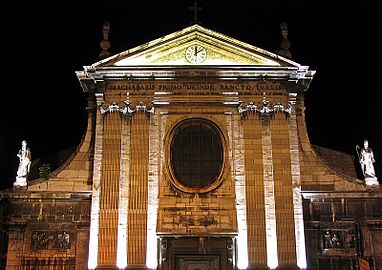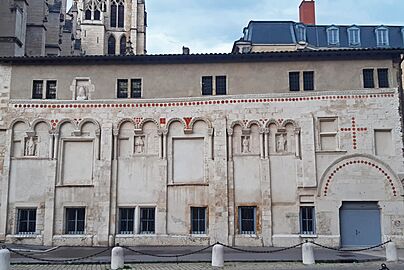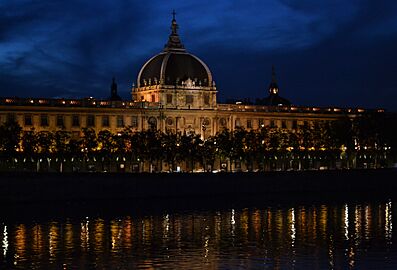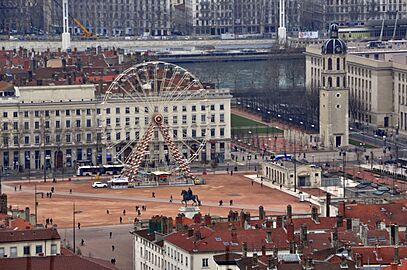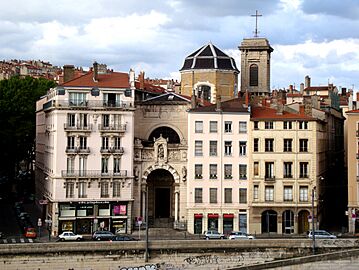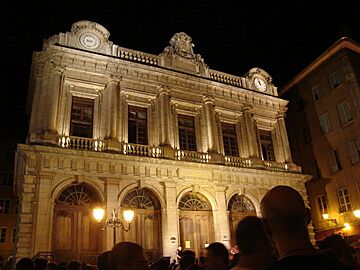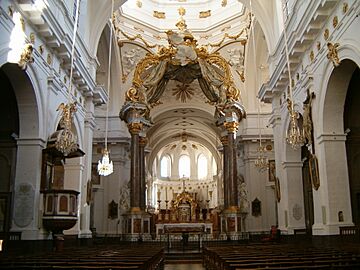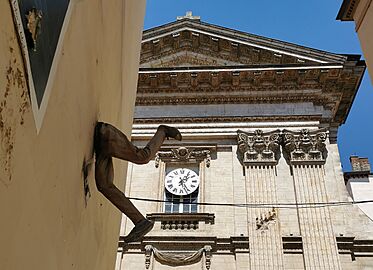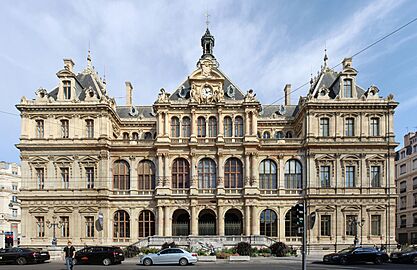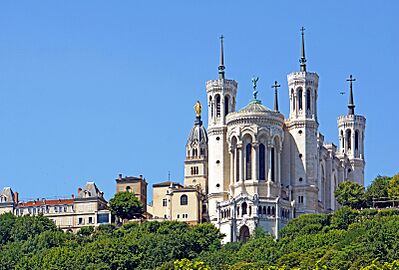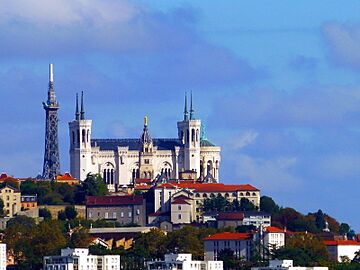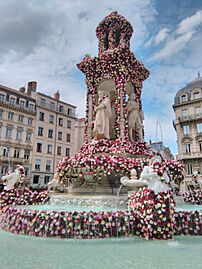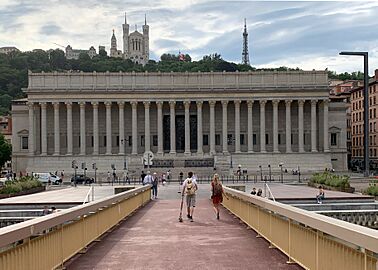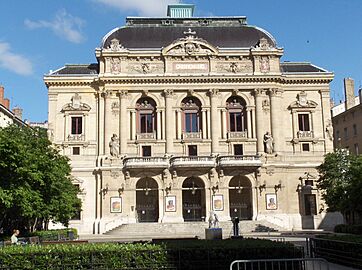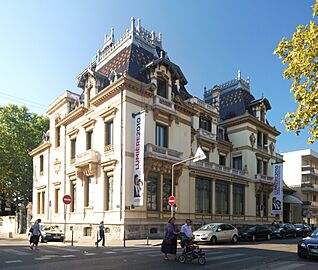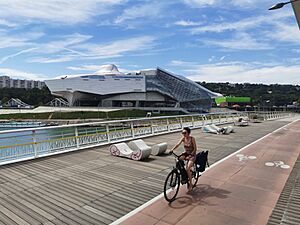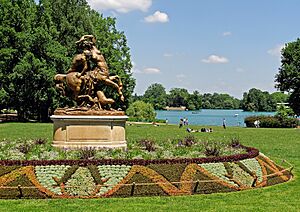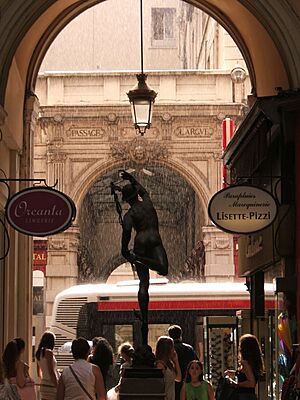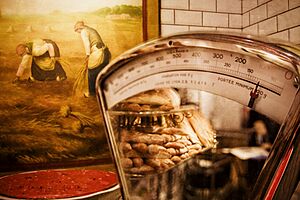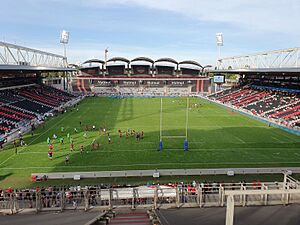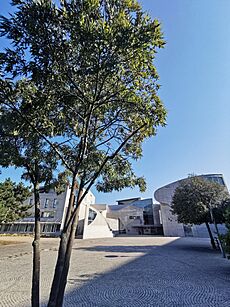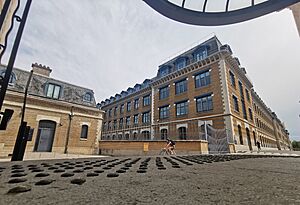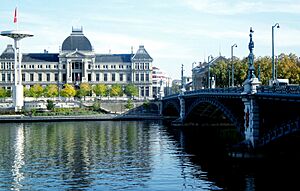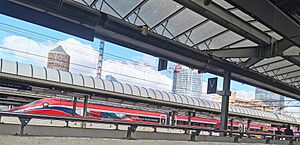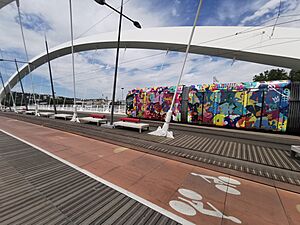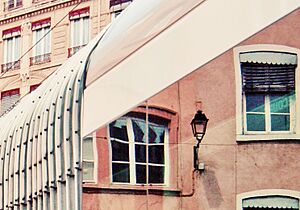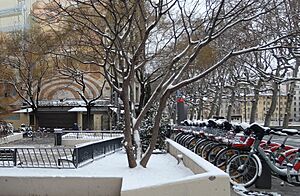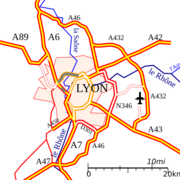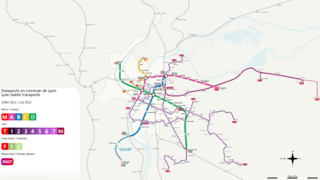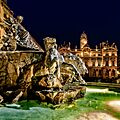Lyon facts for kids
Quick facts for kids
Lyon
Liyon (Arpitan)
|
|||
|---|---|---|---|
|
Prefecture and commune
|
|||
|
Basilica of Notre-Dame de Fourvière
Place des Terreaux with the Fontaine Bartholdi
Parc de la Tête d'or
Confluence District
Vieux Lyon
Pont Lafayette
La Part-Dieu
|
|||
|
|||
| Motto(s):
Avant, avant, Lion le melhor
(old Franco-Provençal for "Forward, forward, Lyon the best") Virtute duce, comite fortuna ("With virtue as guide and fortune as companion") |
|||
| Country | France | ||
| Region | Auvergne-Rhône-Alpes | ||
| Metropolis | Metropolis of Lyon | ||
| Arrondissement | Lyon | ||
| Subdivisions | 9 arrondissements | ||
| Area
1
|
47.87 km2 (18.48 sq mi) | ||
| • Urban
(2020)
|
1,141.4 km2 (440.7 sq mi) | ||
| • Metro
(2020)
|
4,605.8 km2 (1,778.3 sq mi) | ||
| Population
(2021)
|
522,250 | ||
| • Rank | 3rd in France | ||
| • Density | 10,909.8/km2 (28,256/sq mi) | ||
| • Urban
(Jan. 2021)
|
1,702,921 | ||
| • Urban density | 1,491.96/km2 (3,864.15/sq mi) | ||
| • Metro
(Jan. 2021)
|
2,308,818 | ||
| • Metro density | 501.285/km2 (1,298.322/sq mi) | ||
| Time zone | UTC+01:00 (CET) | ||
| • Summer (DST) | UTC+02:00 (CEST) | ||
| INSEE/Postal code |
69123 /69001-69009
|
||
| Elevation | 162–349 m (531–1,145 ft) | ||
| 1 French Land Register data, which excludes lakes, ponds, glaciers > 1 km2 (0.386 sq mi or 247 acres) and river estuaries. | |||
Lyon is a big city in France. It is the second largest city in France by population within its wider metropolitan area. It is the third largest city within its city limits. Lyon is where the Rhône and Saône rivers meet. This is northwest of the French Alps.
In January 2021, Lyon had about 522,250 people living in its city area. But if you count the surrounding towns, the Lyon metropolitan area had over 2.3 million people. Since 2015, Lyon and 58 nearby towns have formed the Metropolis of Lyon. This group manages many city issues. Lyon is also the main city of the Auvergne-Rhône-Alpes region.
Lyon was once the capital of the Gauls during the Roman Empire. It became a very important place for business during the Renaissance. The city is famous for its amazing food and gastronomy. It also has many old and beautiful buildings. Because of this, parts of Lyon like Old Lyon and the Fourvière hill are on the UNESCO World Heritage List.
Lyon was also important for making silk. The city played a big part in the history of movies. This is because Auguste and Louis Lumière invented the cinematograph here. Lyon is also known for its light festival, the Fête des lumières. This festival starts every year on December 8th and lasts for four days. This is why Lyon is called the "Capital of Lights."
Today, Lyon is a major center for banking and industries like chemical, pharmaceutical, and biotech. It also has a growing software industry, especially for video games. Lyon is home to many famous universities and schools. It is the second-largest student city in France. Nearly 200,000 students live in the Metropolis of Lyon. Lyon also hosts the main offices for Interpol and Euronews.
Contents
Exploring Lyon's Past
What's in a Name?
The name Lyon comes from the old Gallic word Lugdun or Lugdunon. The Romans later called it Lugdunum. This name has two parts. The first part, Lug, might be from the Celtic god Lugh. Or it could mean "crow" (Lug's messenger) or "light". The second part, dunos, means "fortress" or "hill". So, Lyon could mean "hill of the god Lug," "hill of the crows," or "shining hill."
In Roman times, the city was called Caput Galliæ. This means "capital of the Gauls." Even today, the Archbishop of Lyon is called the Primate of Gaul. This is a special title that honors Lyon's past.
During the French Revolution, Lyon was briefly renamed Commune-Affranchie. This means "Emancipated Commune." But it got its original name back in 1794.
Ancient Roman City
In 43 BC, the Roman Senate decided to build a settlement for Roman war refugees. These refugees were from a nearby city. They settled where the Saône and Rhône rivers meet. This new city was called Colonia Copia Felix Munatia. It was later known as Lugdunum.
The Romans saw that Lugdunum was in a great spot. It was where two rivers met, making it easy to travel and trade. The city became the starting point for major Roman roads. It quickly became the capital of the Roman province called Gallia Lugdunensis. Two Roman Emperors, Claudius and Caracalla, were born here.
Early Christians in Lyon faced hard times. Many were killed for their beliefs. Irenaeus was an important bishop in Lyon during the second century.
Later, in 443, the Romans created the Kingdom of the Burgundians. Lugdunum became its capital in 461. Lyon did not become part of France until the 14th century.
Modern Lyon's Development
In the late 1400s, Italian merchants started many fairs in Lyon. This made Lyon a very important business center in France. Even when international banking moved to other cities, Lyon remained France's banking hub.
During the Renaissance, Lyon grew because of the silk trade. This brought many Italian influences to the city's buildings. In the 1400s and 1500s, Lyon was also a key place for writers and book publishing.
In 1572, there was mass violence in Lyon. Catholics attacked Protestant Huguenots during the St. Bartholomew's Day Massacre. Two centuries later, Lyon faced more violence during the French Revolution. The city rebelled against the government. Revolutionary armies surrounded Lyon for over two months. Many buildings were destroyed. Over 2,000 people were executed. The government even ordered the city's name to be changed to "Liberated City." But Napoleon later ordered the city to be rebuilt.
Lyon became an important industrial city in the 1800s. In 1831 and 1834, the canuts (silk workers) had two big uprisings. They wanted better working conditions and pay. In 1862, Lyon started its first funicular railway to help people travel up the hills.
During World War II, Lyon was a center for the Nazi forces. But it was also a strong base for the French Resistance. The city's secret passages, called traboules, helped people escape. Lyon was freed on September 3, 1944. Today, there is a museum about the Resistance in Lyon.
Lyon's Landscape
The Rhône and Saône rivers meet south of Lyon's old city center. They form a peninsula called the "Presqu'île." This area has two large hills to the west and north. Place Bellecour is on the Presqu'île. It is one of the biggest public squares in France.
The northern hill is La Croix-Rousse. It's known as "the hill that works." This is because it used to have many small silk workshops. The city was famous for its silk industry.
The western hill is Fourvière. It's called "the hill that prays." This is because it has the Basilica of Notre-Dame de Fourvière and many convents. The Vieux Lyon area is also here. It has the Tour métallique, a tall TV tower. Fourvière, parts of the Presqu'île, and much of La Croix-Rousse are World Heritage Sites.
East of the Rhône river is a large flat area. This is where most of modern Lyon is built. It includes La Part-Dieu, a big business center. It has tall buildings like Tour Incity and Tour Part-Dieu. The city's main train station, Gare de Lyon-Part-Dieu, is also here.
North of this area is the sixth arrondissement. It has one of Europe's largest urban parks, the Parc de la Tête d'or. The international headquarters of Interpol is also located here.
Lyon's Weather
Lyon has a humid subtropical climate. This means it has warm, wet summers and cool winters. The average temperature in January, the coldest month, is about 4.1°C (39.4°F). In July, the warmest month, it's about 22.6°C (72.7°F). Lyon gets a good amount of rain all year. The driest months are in winter. The highest temperature ever recorded was 41.4°C (106.5°F) in August 2003. The lowest was -24.6°C (-12.3°F) in December 1938.
| Climate data for Lyon (LYN), elevation: 197 m (646 ft), 1991–2020 normals, extremes 1920–present | |||||||||||||
|---|---|---|---|---|---|---|---|---|---|---|---|---|---|
| Month | Jan | Feb | Mar | Apr | May | Jun | Jul | Aug | Sep | Oct | Nov | Dec | Year |
| Record high °C (°F) | 19.1 (66.4) |
21.9 (71.4) |
26.0 (78.8) |
30.1 (86.2) |
34.2 (93.6) |
38.4 (101.1) |
40.4 (104.7) |
41.4 (106.5) |
35.8 (96.4) |
28.4 (83.1) |
23.0 (73.4) |
20.2 (68.4) |
41.4 (106.5) |
| Mean daily maximum °C (°F) | 7.1 (44.8) |
9.0 (48.2) |
13.8 (56.8) |
17.4 (63.3) |
21.5 (70.7) |
25.6 (78.1) |
28.2 (82.8) |
28.0 (82.4) |
23.1 (73.6) |
17.7 (63.9) |
11.4 (52.5) |
7.7 (45.9) |
17.5 (63.5) |
| Daily mean °C (°F) | 4.1 (39.4) |
5.2 (41.4) |
9.0 (48.2) |
12.3 (54.1) |
16.3 (61.3) |
20.3 (68.5) |
22.6 (72.7) |
22.3 (72.1) |
17.9 (64.2) |
13.7 (56.7) |
8.1 (46.6) |
4.8 (40.6) |
13.0 (55.4) |
| Mean daily minimum °C (°F) | 1.1 (34.0) |
1.4 (34.5) |
4.2 (39.6) |
7.2 (45.0) |
11.2 (52.2) |
15.0 (59.0) |
17.0 (62.6) |
16.6 (61.9) |
12.8 (55.0) |
9.6 (49.3) |
4.9 (40.8) |
2.0 (35.6) |
8.6 (47.5) |
| Record low °C (°F) | −23.0 (−9.4) |
−22.5 (−8.5) |
−10.5 (13.1) |
−4.4 (24.1) |
−3.8 (25.2) |
2.3 (36.1) |
6.1 (43.0) |
4.6 (40.3) |
0.2 (32.4) |
−4.5 (23.9) |
−9.4 (15.1) |
−24.6 (−12.3) |
−24.6 (−12.3) |
| Average precipitation mm (inches) | 49.8 (1.96) |
41.6 (1.64) |
49.4 (1.94) |
68.9 (2.71) |
80.9 (3.19) |
74.1 (2.92) |
67.4 (2.65) |
65.5 (2.58) |
82.5 (3.25) |
99.8 (3.93) |
87.2 (3.43) |
53.7 (2.11) |
820.8 (32.31) |
| Average precipitation days (≥ 1.0 mm) | 8.1 | 7.9 | 8.4 | 9.0 | 10.3 | 8.5 | 7.5 | 7.2 | 7.3 | 9.9 | 9.4 | 9.2 | 102.8 |
| Mean monthly sunshine hours | 71.1 | 102.4 | 173.7 | 197.7 | 223.8 | 256.5 | 288.1 | 263.1 | 204.1 | 131.4 | 78.9 | 58.7 | 2,049.5 |
| Source 1: Meteo France | |||||||||||||
| Source 2: Meteo Lyon | |||||||||||||
How Lyon is Governed
City Districts (Arrondissements)
Like Paris and Marseille, Lyon is divided into smaller areas called municipal arrondissements. Each one has its own council and town hall. There are nine arrondissements in Lyon. They were created over time as the city grew.
These districts are grouped by Lyon's two main rivers:
- West of the Saône river is the fifth arrondissement. This includes the old city of Vieux Lyon and Fourvière hill. The ninth arrondissement is just north of it.
- Between the two rivers, on the Presqu'île, are the second, first, and fourth arrondissements. The second has most of the city center. The first is north of that. The fourth covers the top of La Croix-Rousse hill.
- East of the Rhône river are the third, sixth, seventh, and eighth arrondissements.
Lyon's Mayor
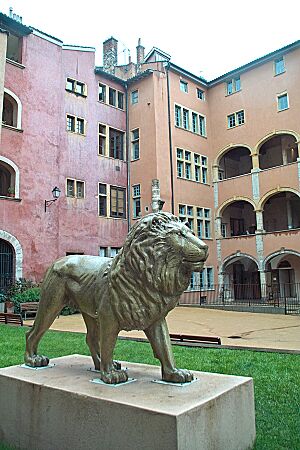
The current mayor of Lyon is Grégory Doucet. He started his term in 2020.
The Metropolis of Lyon

Since 2015, Lyon and 58 nearby towns have formed the Metropolis of Lyon. This is a special authority that handles most city issues. It is the only one of its kind in France. The people living in the Metropolis directly elect its council members.
Places to See in Lyon
Ancient Roman Sights
- The Roman ruins on Fourvière Hill. These include the Ancient Theatre of Fourvière, the Odeon of Lyon, and the Gallo-Roman museum.
- Amphitheatre of the Three Gauls – the remains of a Roman amphitheater.
Medieval and Renaissance Buildings
- Cathedral of St. John. This is a medieval church with parts built in the 13th, 14th, and 15th centuries. It is the main church in the city.
- Basilica of St-Martin-d'Ainay. This is one of the few Romanesque churches left in Lyon.
- Vieux Lyon (Old Lyon). This is the medieval and Renaissance part of the city. It has shops, restaurants, and cobbled streets.
- Many Renaissance hôtels particuliers (grand townhouses) in Old Lyon.
17th and 18th Century Architecture
- City Hall on the Place des Terreaux. It was built by famous architects.
- Musée des beaux-arts de Lyon, a fine arts museum. It is in a former 17th-century convent.
- Hôtel-Dieu de Lyon (17th and 18th century). This was a historical hospital with a beautiful chapel.
- Place Bellecour, one of the largest town squares in Europe.
19th Century and Modern Buildings
- Opéra Nouvel (1831). This opera house was updated in 1993 by architect Jean Nouvel.
- Basilica of Notre-Dame de Fourvière. This is a large 19th-century church on top of Fourvière Hill.
- Tour métallique de Fourvière (1894).
-
Museum of Institut Lumière
Museums to Visit
- Musée des beaux-arts de Lyon (Fine Arts Museum). This is the city's main museum. It has a huge collection of paintings, sculptures, and ancient art. It also has the second-largest collection of Egyptian artifacts in France.
- Gallo-Roman Museum. This museum shows many valuable items found from Roman Lyon.
- Centre d'histoire de la résistance et de la déportation. This museum tells the story of the French Resistance during World War II.
- Musée des Confluences. This is a new museum about science and anthropology. It opened in 2014.
- Musée des Tissus et des Arts décoratifs. This museum has one of the world's largest collections of textiles.
- Musée Gadagne. This museum is about the history of Lyon. It has a big collection of puppets.
- Musée Miniature & Cinéma. This museum features tiny movie sets, movie props, and special effects.
Parks and Green Spaces
- Parc de la Tête d'or. This is Lyon's largest urban park. It covers 117 hectares (289 acres). It has a big lake where you can go boating in summer.
- Jardin botanique de Lyon. This botanical garden is inside the Parc de la Tête d'Or. It is France's largest city botanical garden.
- Parc de Gerland. This park is in the south of the city.
- Parc des hauteurs. This park is on Fourvière hill.
Lyon's Economy
Lyon has a very strong economy. It is the second richest city in France after Paris. Lyon and its region are important for business in Europe. Lyon is a major center for banking, chemicals, and medicine. It also has many high-tech industries. These include software development and video games. Lyon is also home to the P4-Inserm–ean Merieux Laboratory. This lab does important vaccine research.
Many big companies have their main offices in Lyon. These include Groupe SEB, Sanofi Pasteur, and Renault Trucks. International organizations like Interpol also have their headquarters here.
Tourism is a big part of Lyon's economy. Many people visit for business or for fun. Popular festivals like the Fête des lumières attract many tourists.
Culture and Traditions
The Lumière brothers invented cinema in Lyon in 1895. The Institut Lumière is a museum in Auguste Lumiere's old house. It shows many of their first inventions.
Every year on December 8th, Lyon celebrates the Festival of Lights (la Fête des lumières). People place candles in their windows. The city puts on big light shows on important buildings. This festival thanks the Virgin Mary for saving the city from a plague long ago.
The Opéra Nouvel (New Opera House) is home to the Opéra National de Lyon. It was redesigned by the famous architect Jean Nouvel. Lyon is also known for its "trompe l'œil" walls. These are paintings that trick your eye into thinking they are real objects.
UNESCO World Heritage Site
In 1998, the historic parts of Lyon became a UNESCO World Heritage Site. UNESCO said Lyon shows how cities have grown for over two thousand years. The protected areas include the Roman district, Old Lyon, the silk district (Croix-Rousse), and the Presqu'île.
Both Old Lyon and Croix-Rousse are famous for their narrow passages called traboules. These passages go through buildings and connect streets. They were first built in the 4th century. Traboules helped people get to the Saône river quickly. They also helped silk workers carry their goods from workshops to merchants.
Delicious Food in Lyon
Lyon has a long history of amazing food. Some food critics have called it "the gastronomic capital of the world." Famous chefs like Paul Bocuse helped make Lyonnaise cuisine known worldwide.
A bouchon is a traditional Lyon restaurant. They serve local dishes like sausages, duck pâté, or roast pork. They also serve local wines. Two famous wine regions, Beaujolais and Côtes du Rhône, are near Lyon.
Another Lyon tradition is "mâchons." This is a type of brunch food made with local meats. Silk workers used to eat mâchons after their shifts. Other local dishes include coq au vin (chicken in wine) and quenelle (a type of dumpling).
More recently, the french tacos was invented near Lyon. It is now famous around the world.
Sports in Lyon
Lyon is home to the football club Olympique Lyonnais (OL). Their men's team plays in Ligue 1. They have won the championship seven times in a row! The OL women's team, Olympique Lyonnais Féminin, is also very successful. They have won many championships and the UEFA Women's Champions League eight times. Lyon hosted the 2019 FIFA Women's World Cup semi-finals and final.
Lyon also has a rugby union team, Lyon OU. They play in the Top 14 league. There is also an ice hockey team, the Lyon Hockey Club. The city is also known for its Olympic ice dancing champions. Lyon-Villeurbanne has a basketball team called ASVEL.
Street Art
Since 2000, a group of graffiti artists called Birdy Kids has decorated buildings and walls in Lyon. In 2012, they were chosen to represent the city as cultural ambassadors.
People of Lyon
In January 2021, the city of Lyon had 522,250 people. The wider Metropolis of Lyon had 1,424,069 people.
Learning in Lyon
Universities and Colleges
Lyon has many excellent universities and higher education schools. Some of the main ones include:
- École Centrale de Lyon
- École Normale Supérieure de Lyon
- EM Lyon (Business School)
- Institut d'études politiques de Lyon (Sciences Po Lyon)
- INSA Lyon (Engineering School)
- Université Claude Bernard (Lyon 1)
- Université Lumière (Lyon 2)
- Université Jean Moulin (Lyon 3)
- Catholic University of Lyon
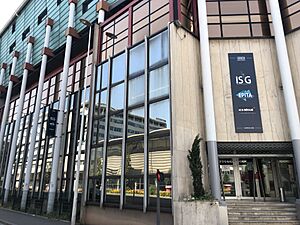
Schools for Kids
There are also international private schools in the Lyon area. These include:
- Cité Scolaire Internationale de Lyon
- International School of Lyon
Getting Around Lyon
Lyon–Saint-Exupéry Airport is east of Lyon. It has flights to many places. The Rhônexpress tram connects the airport to the city center in under 30 minutes. Lyon also has a smaller airport, Lyon-Bron Airport.
Lyon has two main train stations: Lyon-Part-Dieu and Lyon Perrache. Lyon was the first city connected to Paris by the fast TGV train in 1981. Now, TGV trains connect Lyon to many other cities in France and Europe.
The city has a good road network. Several highways meet in Lyon.
The Transports en commun lyonnais (TCL) is Lyon's public transport system. It includes the metro, tramways, and buses. The metro has four lines and 42 stations. There are eight tram lines. The bus network includes trolleybuses and regular buses. There are also two funicular lines that go up the hills.
In 2005, Lyon started Vélo'v, a bike-sharing system. You can rent bikes from many stations around the city. The first 30 minutes are free. In 2011, the Auto'lib car rental service was also introduced.
Maps of Lyon's Transport
Lyon's International Friends
Lyon is part of a program called "Intercultural cities." This means it works with other cities to promote different cultures. Lyon is twinned with many cities around the world, including:
- Barcelona, Spain
- Birmingham, England, United Kingdom
- Boston, United States
- Frankfurt, Germany
- Guangzhou, China
- Leipzig, Germany
- Milan, Italy
- Montreal, Canada
- Osaka, Japan
- St. Louis, United States
- Turin, Italy
- Yokohama, Japan
Famous People from Lyon
Images for kids
See also
 In Spanish: Lyon para niños
In Spanish: Lyon para niños


